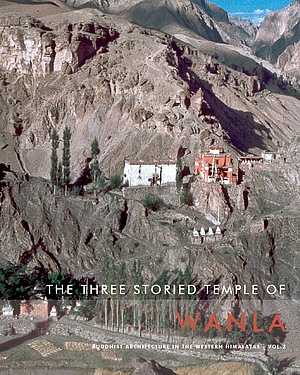The Three Storied Temple of Wanla
Buddhist Architecture in the Western Himalayas, Band 2
Carmen Auer/Holger Neuwirth (eds.)
Graz: Publishing Company of Graz University of Technology, 2015
English, 205 pages, paperback
ISBN 978-3-85125-391-7
EUR 78.00
The settlement of Wanla is located in Western Ladakh on the Yalpola River, a southern tributary of the Indus River, about 68 kilometers linear distance from Leh. At an altitude of 3,260 meters, the climate is somewhat milder than in higher regions and offers more comfortable living conditions.
The small mountain ridge above the settlement of Wanla is dominated by the imposing ruins of an ancient castle complex that are mainly situated on a rocky crag on the northwestern side.
With its walls painted in red and white, the three-storied temple is easily recognized as a sacred building. Today it is the center of the whole complex. The path around the temple allows the ritual circumambulation. Despite the fact that Wanla is located within an active seismic zone, this temple has survived for over 700 years.
The solitary position of the temple within the castle and the hints of its founder in the temple inscription indicate that the temple may have been used as both a palace chapel and a three-storied initiation chapel. Compared to other three-storied temple buildings, Wanla temple can be even described as a typologically unique palace chapel. The temple of Wanla appears today almost in its original form. Since its construction, the temple has been a monument of the Drikung Kagyu school, a sub-school of the Kagyupa school of Tibetan Buddhism. The analysis, which was based on specific research results, primarily sheds light on the complexity of Buddhist architecture in the Western Himalayas, especially on the connections between building aspects such as construction principles and materials as well as aspects related to content and aesthetics like proportion and shape. Those elements are equally inherent to architecture as they are to visual arts, sculptures, and paintings.
Since 1999 Holger Neuwirth has been in charge of several research projects focusing on the documentation, analysis, reconstruction, and other aspects related to the preservation of sacred architecture from the tenth to fifteenth centuries in the Western Himalayas. The projects in question were funded by the Austrian Science Fund (FWF). Members of Graz University of Technology conducted the work under Neuwirth’s guidance. A first field research project focused on the temple complex and its surroundings was started in 1998 with the financial aid of Edoardo Zentner, Zurich. With the help of FWF, this research continued in 2000, 2003, 2004, 2005, and 2009. This book presents the cumulative data gathered during the research programs.
Carmen Auer and Holger Neuwirth teach and conduct research in the Institute of Architectural Theory, Art History and Cultural Studies.

